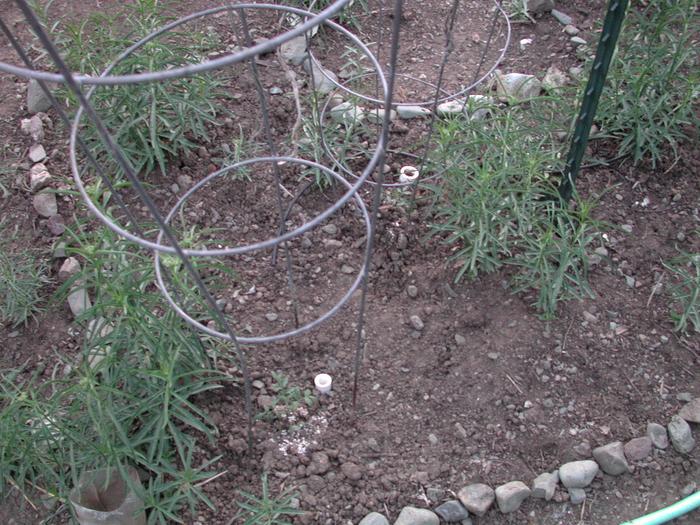
If you look between the tines of the three-ring cages, you may see the speck of green of a Dwarf Green Grape. There are two here, doubled up; the reason I can do that -- and use the flimsy store-bought cages to boot -- is that the dwarf gene keeps them about four feet tall. I would never try a three-ring cage with a regular indeterminate tomato; I might find it eventually in December, after digging through the mounds of dead vines that ate it.
This is my own dwarf variant, that I got in my garden last year. After a successful growout, where they all dwarf (and, save for two plants in Australia, they all seem to be dwarfing) I'll distribute seed to whomever wants it. I just wanted to discover any crossing or weirdnesses early on, before they went out into the wider world.
The white spots are the four-inch sections of PVC pipe buried next to the tomatoes, into which the drip system feeds. I did that for two reasons, both related to my habit of letting the ground dry out completely to create a two-inch hard crust in summer... the first reason is that I wanted to be able to feed them without digging a hole in the cement-like crust the ground becomes by August; this way I can drop the bloodmeal etc. down the pipe, and the emitter waters it in. The second reason was the ease of checking emitters: is it running properly? Pull it out and check. Much simpler than digging it up and reburying it.
Neither of these has a watering line yet; I need to split the line for them, and that means a run to the hardware store to get more emitters.
The tomatoes are surrounded by milkweed; I'm not worried about that, mostly because milkweed is a good neighbor. It's a very light feeder, not thirsty, and doesn't shade much. Its worst habit is attracting aphids, which linger on the plants because ladybugs don't like bitter aphids. But I can take care of that problem.